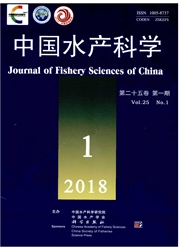

 中文摘要:
中文摘要:
基于2000年6月和2014年11月黄海南部采集的浮游动物和不同生长阶段鳀(Engraulis japonicus)的胃含物(饵料)组成分析资料,研究鳀的饵料粒级分布与摄食粒级选择性及其与环境生物组成的关系,旨在推进粒级在传统摄食生态分析中的应用。结果显示:黄海南部鳀的饵料种类组成与环境中生物种类组成有关;各体长组中,鳀的饵料粒级多样性与种类多样性分布趋势相似;体长为110 mm左右的鳀的饵料种类多样性和粒级多样性水平最高;鳀的饵料粒级均值随鱼体体长增加而增加;体长约为30 mm和≥70 mm的鳀有明显的饵料粒级转换。根据上述结果,认为在鳀胃含物分析过程中,整合环境中饵料生物的相对组成和粒级大小,可有效评价鱼类对饵料的粒级选择性。
 英文摘要:
英文摘要:
The Japanese anchovy Engraulis japonicus is a dominant species in the food web of the Yellow Sea, China. It is not only a small pelagic zooplankton feeder, but also the prey for over 30 important higher trophic level species. Its population plays a crucial role as wasp-waist control functional group in the marine ecosystem in the Yellow Sea. In traditional ecological research, the diets of the anchovy were determined based on species analysis of the gut content or stable isotope, fatty acid analysis. In this study, the application of particle size in the food analysis of fishes was advanced by analyzing the prey size compositions of anchovy in relation to the fish species body size. Data for species and size classification of prey in the anchovy gut content were collected, and zooplankton sorting was performed between June 2000 and November 2014 in the southern part of the Yellow Sea. The anchovy body size (standard length) ranged from 10 mm to 150 mm. Results showed that the species compo- sition of anchovy diet was mostly determined by the environmental living conditions. Most zooplankton species in the diets of anchovy could be found in the environmental waters, The species and size diversity of diets varied similarly along with the anchovy body size. Both diversity indices of species and particle size had the highest values at the anchovy body size class of 110 mm. The mean size of prey particles increased gradually with an- chovy body size. Larger anchovy tended to prey on relatively bigger items. According to the prey selectivity, three prey size shifts were found for the anchovy with body size: ≤ 30 mm, 30-70 mm, and 〉i 70 ram. Thus, integrat- ing particle size into anchovy prey analysis could be useful for the evaluation of feeding selectivity in the fish feeding ecology analysis.
 同期刊论文项目
同期刊论文项目
 同项目期刊论文
同项目期刊论文
 期刊信息
期刊信息
